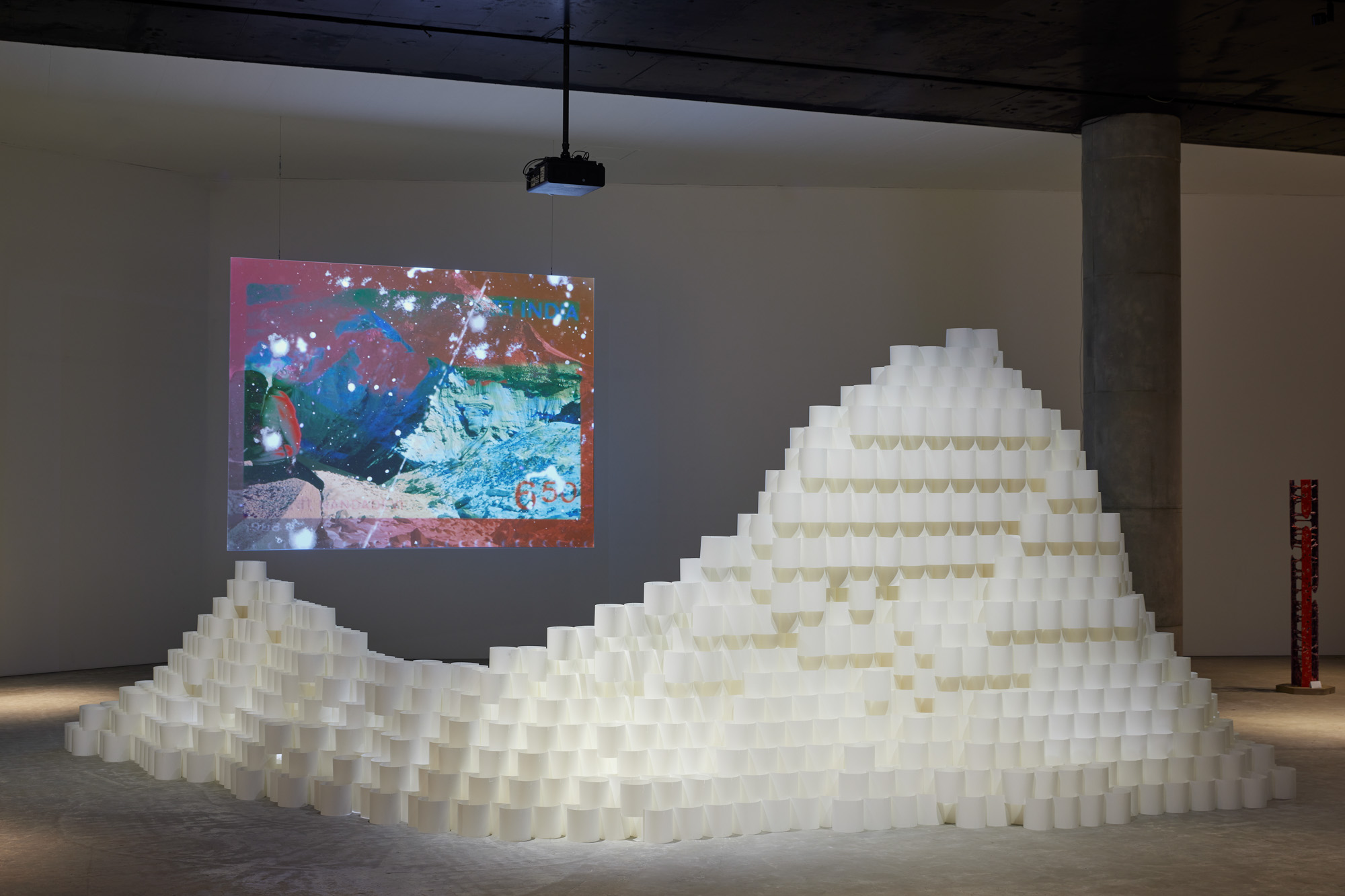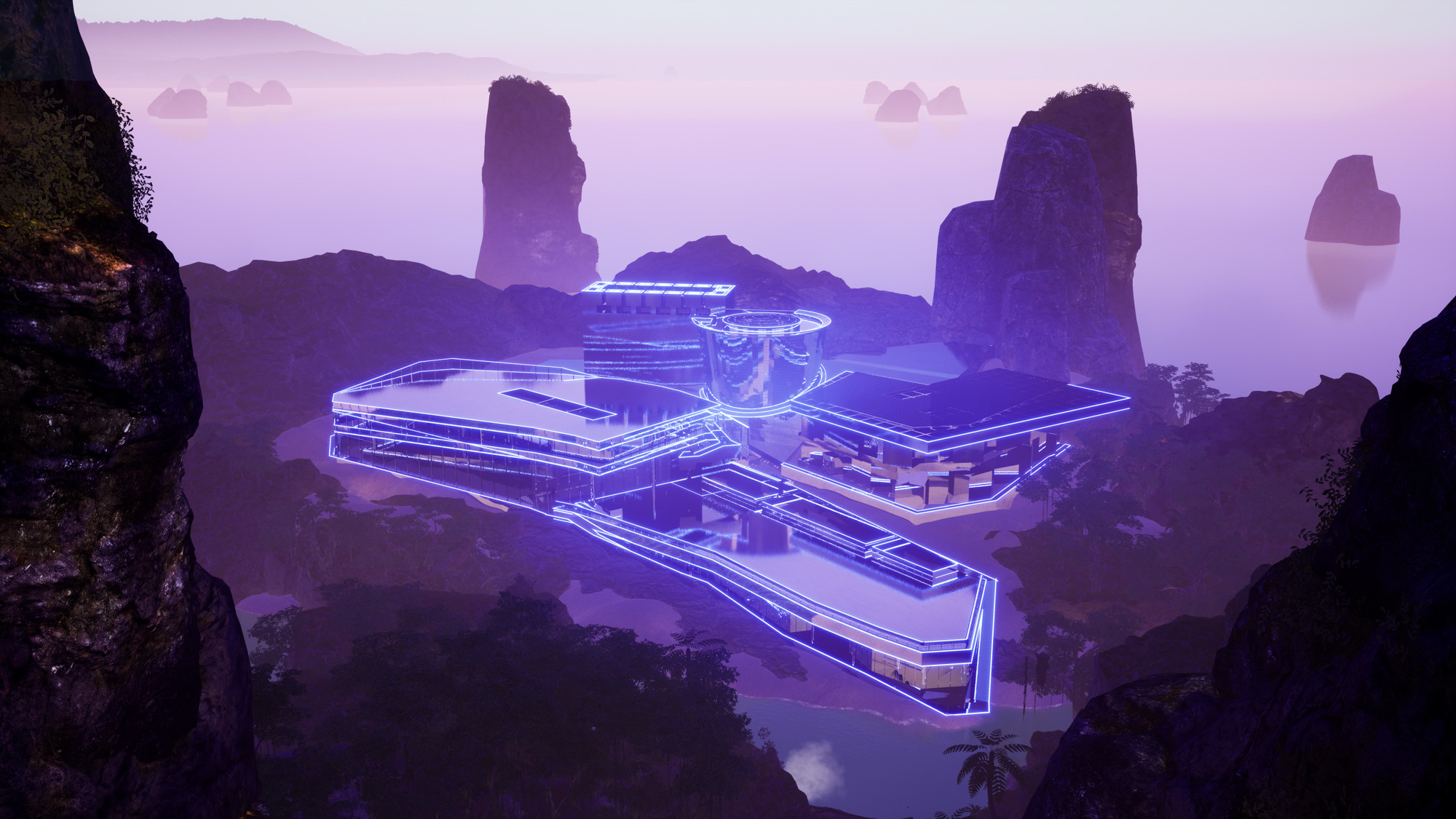“Cloud Walkers” at the Leeum Museum of Art
By Monica Fernandez

Installation view of (back) HIMALI SINGH SOIN‘s Static Range, 2020, full color animation and stereo sound: 15 min, and (front) KAZUYA KATAGIRI’s Paper Dune, 2022, paper and LED light, 780 × 760 × 400 cm, at "Cloud Walkers," Leeum Museum of Art, Seoul, 2022. Photo by Sangtae Kim. Copyright Katagiri Architecture + Design. All images courtesy the artists and Leeum Museum of Art unless otherwise noted.
“What if . . . we can be a cosmic traveller and . . . a boring ordinary person living in a cubicle and an exciting psychonaut in the age of iOs at the same time?” The opening lines of Natasha Tontey’s Manifesto of Tactile and Fanciful Tactics on How to Build a Speculative Future (2018–19) may sound far-fetched but they captured the spirit of speculative thinking that undergirded “Cloud Walkers,” the Leeum Museum of Art’s latest blockbuster exhibition. With projects by 24 art and design practitioners active in Asia or engaged with Asian culture, “Cloud Walkers” posited an optimistic future where buzzword binaries like “virtual/physical” and “human/machine” fall away in the face of artistic imaginations and scientific research. Each work loosely addressed three broad themes: “Mindful Material,” which explored sustainable methods and materials of living; “Extranormal Surf Morph Warp,” where works melded the digital/virtual, human/post-human as new ways of living in the future; and “Synesthetic Immersion,” which imagined how the physical senses might be engaged in the human-and-machine age. All these were subsumed under the metaphor of the “cloud,” which was used in its climate-related, imaginative, and digital senses.
Upon entering the ground-floor gallery, one first encountered Japanese architect Kazuya Katagiri’s Paper Dune (2022), a sprawling installation made up of 4,000 rolls of eco-friendly paper stacked to resemble a mountain range. Closer examination revealed that despite its imposing size, the cylinders were arranged without any adhesive, implying temporality and fragility. Paper Dune served as a fitting physical marker for the start of the show, introducing ideas of technology and innovation, though perhaps not yet imagination.
.jpg)
Installation view of LU YANG‘s DOKU – Hello World, 2022, single-channel video: 3 min 25 sec, inside DOAN THANH HA’s Floating Bamboo House, 2022, bamboo, guot grasses, plastic bottles, and steel, 600 × 600 × 535 cm, at "Cloud Walkers," Leeum Museum of Art, Seoul, 2022. Photo by Sangtae. Copyright Doan Thanh Ha (H&P Architects) and Lu Yang.
In “Cloud Walkers,” artworks were not grouped according to themes to reinforce their interconnectivity and to demonstrate how such realities coexist. Some works were even situated inside one another, as was the case with architect Đoàn Thanh Hà’s Floating Bamboo House (2022) and Lu Yang’s single-channel video installation, DOKU – Hello World (2021). Đoàn’s life-sized Bamboo House is made of local and recycled materials such as guot grass, wood, steel scaffolding, and plastic bottles. Intended for villagers in the Mekong River Delta who are particularly at risk because of climate change, its design echoes the large, pitched roofs of traditional homes in the central highlands of Vietnam. An LED screen was installed inside Bamboo House, which presented Lu Yang’s interdimensional avatar, Doku, who exists in a virtual realm but is nevertheless plagued by questions of meaning and purpose. Using the latest in digital-capturing technology, action data and facial micro-expressions from four traditional Indonesian dancers and popular Tokyo-based dancer kEnkEn were fed into Doku’s rendering, resulting in hyperrealistic, otherworldly movement as the avatar introduces itself through dance. This pairing—one of the strongest in the show—presented viewers a vivid possible future: a society co-habited by humans who dwell in floating structures while their avatars “freely” pursue metaphysical questions as they effortlessly traverse cultural and dimensional boundaries.
.jpg)
MINKI HONG, Real Survival Guide Gongjung Dosi – Episode 2: Rover the Digital Guide Dog, 2022, still from two-channel video with color and sound: 15 min 48 sec.
,%202022.jpg)
LAWRENCE LEK, Nepenthe Zone (Leeum), 2022, still from two-channel 4K video and an open world video game for Windows PC. Courtesy the artist and Sadie Coles HQ, London.
Moving past the idea of location-based living (whether in the physical or meta- world), one floor up, viewers encountered the works of Minki Hong and Lawrence Lek, which both delve into a society without the virtual/physical distinction. A large LED screen telecasts Hong’s Real Survival Guide Gongjung Dosi – Episode 2: Rover the Digital Guide Dog (2022), wherein a television station broadcasting from a “cutting-edge studio and communications tower” in the sky covers the challenges of persons with disabilities living on the ground in Seoul. The video is edited to look like a typical news channel—complete with intro music and animation—but the newsroom and the people in it are entirely digital. Represented by his digital avatar, the news anchor interviews people on the ground, who dial in via livestream while viewers react and ask questions in real time.
In a separate room lit with purple neon lights, Lek’s Leeum (2022), from his open-ended video game Nepenthe Valley (2022– ), simulates a wellness experience in the metaverse. Drawing from the Greek mythological “drug of forgetfulness,” the game follows a Wanderer who lands in an island believed to make visitors forget their miseries. In Leeum, visitors—as the Wanderer—explore the actual museum structure nestled in the misty, mountainous virtual island of Nepenthe and learn its history through a voiceover that narrates the Wanderer’s story, contemplating topics such as change, time, and forgetting, in a form of personal meditation.
“Cloud Walkers” set out with the ambitious goal of giving its audience a peek at the possibilities of an environmentally sustainable and “liberated” future beyond cultural and geopolitical boundaries. While the idea of a boundary-less future may seem a bit far-fetched, most of the works proved witty and imaginative, drawing audiences into their metaverse-like or data-driven worlds. Yet a niggling sense of loneliness and alienation remains. In this future “world in the clouds,” what would private moments with oneself, or intimate moments with one’s loved ones, be like? Will the human need for connection and understanding—as the show suggested—evolve as technology and environmental concerns push inexorably onward? Or are all humans fated to become like Doku—relentlessly yearning for connection and meaning, even in the immortal, virtual realm?
“Cloud Walkers” is on view at Leeum Museum of Art, Seoul, through January 8, 2023.
Monica Fernandez is an editorial intern at ArtAsiaPacific.







